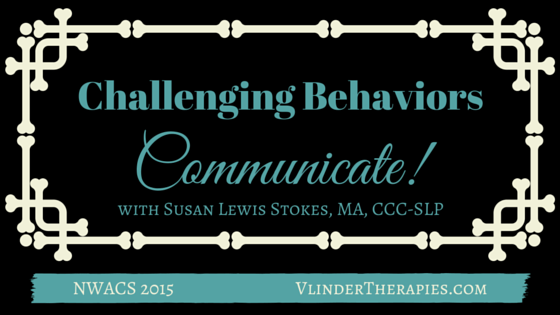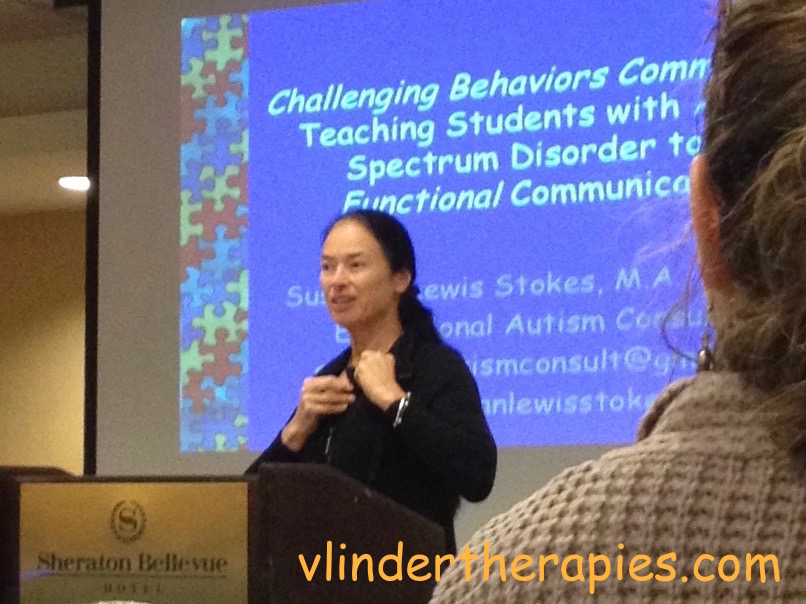NWACS 2015 Fall Conference {Summary Post}

This past Saturday was the Northwest Augmentative Communication Society's (NWACS) annual Fall Conference. Every year, NWACS invites a speaker to come present on a topic relevant to working with children (and adults) with complex communication needs.
Topic: Challenging Behaviors Communicate! Teaching Students with Autism Spectrum Disorder to be Functional Communicators
Speaker: Susan K. Lewis Stokes, MA, CCC-SLP - Susan is a speech-language pathologist and educational autism consultant. She has specialized in autism spectrum disorders for 30 years.
 *Note: Susan's experience is with autism spectrum disorders, and therefore her talk focused on autism spectrum disorders (ASD); however, much of the information is applicable to other diagnoses.
*Note: Susan's experience is with autism spectrum disorders, and therefore her talk focused on autism spectrum disorders (ASD); however, much of the information is applicable to other diagnoses.
Susan started off by warning us that her style is fast-paced and that she had a jam-packed day planned. She did not lie. She also told us she had created a WIKI ("website") specific to this workshop with a collection of resources! How wonderful is that!?!
So, then. Too much to summarize, really. How about some highlights/tips?
The single most important skill a person with autism can learn is functional spontaneous communication. ~Joanne Cafiero
ASD is neurological. We need to first understand their perspective and reason(s) underlying their behavior(s) in order to develop an appropriate intervention. We need to tease out the skills the child needs to learn and then teach those skills. We can rewire the brain, but only if we first truly understand where the breakdown is occurring. Therefore observation and assessment is key. Assessment is a process!
Core Language Skill Areas to assess:
- core conceptual language skills (cause/effect, object permanence, imitation, joint attention, gestural communication, reciprocity/turn-taking, communicative intent)
- core language form skills (how are they communicating?)
- core language function skills (what are they communicating?)
- core social communication skills
- core conversation skills
Susan shared a wonderful modified version of the "iceberg" visual as a means to consider the "hidden" neurological features and characteristics (and communicative functions) underlying the "visible" behaviors. [Available on her WIKI]
To change your student's behavior, you need to be able to make sense of that behavior, and making sense of your student's behavior means making sense of his/her autism. ~Author Unknown
Challenging Behaviors Communicate! (Even if they are verbal!!!)
AAC: an individually designed system to give the student an "alternative" way to spontaneously and functionally communicate through "augmentative" means
Who benefits from AAC? Anyone who is not a spontaneous, functional communicator, whose speech is not effectively meeting their communication needs. Consider the questions: Do they use a conventional way to communicate? Can they pass the "stranger test"? If the answer is no to either of these, then an AAC system is a must!
Can they pass the "stranger test", or do they need an interpreter?
What does appropriate and functional communication look like? It is universally understood by all (including peers!). If the communication needs to be interpreted by a familiar communication partner in order for a stranger to understand the child's intended message, then it is NOT functional. Appropriate and functional communication also experiences limited communication breakdowns.
A couple of free web-based resources Susan shared (check out her WIKI for more!):
Another great resource she shared is the book [affiliate link] DO-WATCH-LISTEN-SAY: Social and Communication Intervention for Children with Autism by Kathleen Quill, which includes a recommended social communication checklist and intervention ideas for each of the core conceptual skill areas (listed above).
I forget how exhausting it really is to sit and learn all day. Susan's presentation style and abundance of stories and video examples helped, though. I always find the NWACS Fall Conferences worth it and am glad to have attended this one.
Were you there, too? What key bits of information did you take away from the day?
Disclosure: This post contains affiliate links for your convenience.
 Tuesday, October 27, 2015 at 8:02PM
Tuesday, October 27, 2015 at 8:02PM  Post a Comment →
Post a Comment →  AAC,
AAC,  behavior,
behavior,  communication | in
communication | in  AAC
AAC
Reader Comments